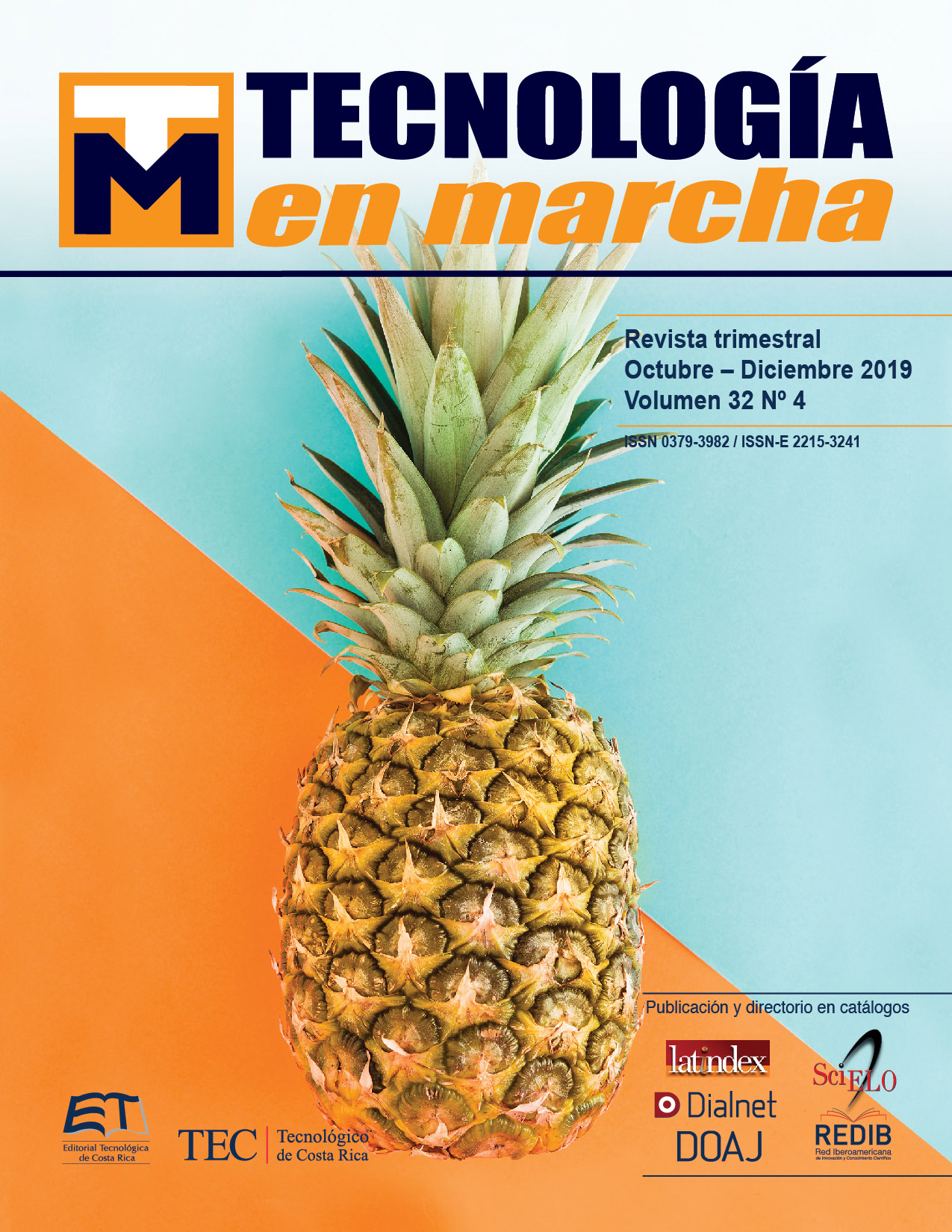Current situation of Municipal Material Recovery Facilities (MRF) in Costa Rica
Main Article Content
Abstract
The promotion of Material Recovery Facilities (MRF) is part of the country strategy to increase the percentage of recovered waste. However, there is a knowledge gap on the management and production processes of the MRF at the national level. This work explores the technical and environmental factors related to the infrastructure, equipment and work procedures of municipally owned MRF in the country. Information of 15 municipal MRF was obtained via a survey, of which 5 were visited in order to corroborate and expand the information collected. In 80% of the facilities, less than 41 ton / month of waste are processed and in 93% of them the separation operation is carried out manually on a static surface, this separation method is suitable for the quantity of waste processed in 87% of cases. The location, topography and accessibility of the lands are generally adequate and do not negatively affect the performance of the facilities. In most cases, the infrastructure was not designed to function as a MRF, so its characteristics are not oriented to maximum efficiency in the operation. The absence of records and written work procedures is a constant in the facilities studied. In most cases, inadequate ergonomic conditions were identified in the classification stations, absence of methods to evaluate the performance of the operators and deficiencies in the personnel training process.
Article Details
Los autores conservan los derechos de autor y ceden a la revista el derecho de la primera publicación y pueda editarlo, reproducirlo, distribuirlo, exhibirlo y comunicarlo en el país y en el extranjero mediante medios impresos y electrónicos. Asimismo, asumen el compromiso sobre cualquier litigio o reclamación relacionada con derechos de propiedad intelectual, exonerando de responsabilidad a la Editorial Tecnológica de Costa Rica. Además, se establece que los autores pueden realizar otros acuerdos contractuales independientes y adicionales para la distribución no exclusiva de la versión del artículo publicado en esta revista (p. ej., incluirlo en un repositorio institucional o publicarlo en un libro) siempre que indiquen claramente que el trabajo se publicó por primera vez en esta revista.
References
[2] C. Cimpan, A. Maul, M. Jansen, T. Pretz and H. Wenzel. (2015, Abr.). “Central sorting and recovery of MSW recyclable materials: A review of technological state-of-the-art, cases, practice and implications for materials recycling. Journal of Environmental Management, 156, pp. 181–199. Doi:10.1016/j.jenvman.2015.03.025
[3] S. Zafar. (2017, Nov. 29). Introduction to MRF [En línea]. Disponible: https://www.ecomena.org/materials-recovery-facility/
[4] “Ley Nº 8839. Ley para la Gestión Integral de Residuos Sólidos.” Diario Oficial La Gaceta N°135, 13 Julio 2010.
[5] Ministerio de Salud. (2016, Abr.). Estrategia Nacional de Separación, Recuperación y Valorización de Residuos (ENSRVR) [En línea]. Disponible: https://goo.gl/mB87FJ
[6] L.D. Jiménez, Comunicación personal, Fundación Aliarse, junio 2018.
[7] H. K. T. Campos. (2014). “Recycling in Brazil: Challenges and prospects”. Resources, Conservation and Recycling, 85, pp. 130–138. Doi: 10.1016/j.resconrec.2013.10.017
[8] M. Torres, Comunicación personal, setiembre 2017.
[9] G. Gómez, Comunicación personal, setiembre 2017.
[10] M. López, Comunicación personal, octubre 2017.
[11] Illinois Recycling Association. (2010, Nov.). Best Operational Practices Manual for Materials Recovery Facilities and Recycling Drop-off Facilities [En línea]. Disponible: http://www.illinoisrecycles.org/wp-content/uploads/2014/10/IRA_BOPM_2010.pdf
[12] M. Pérez. (2016, Mar. 25). Las áreas funcionales de la empresa [En línea]. Disponible: http://publicacionesdidacticas.com/hemeroteca/articulo/069027/articulo-pdf
[13] B. Richers, C. Harvey, F. Casanoves, F. DeClerck and T. Benjamin. “¿Cómo hacer talleres participativos con respuestas individuales?” Agroforestería en las Américas, 48, pp. 157 – 163, Ene. 2011
[14] P. Grandela, I. Honold and P. Mansilla. (2007, Nov.). Guía de Buenas Prácticas Ambientales para Instalaciones de Acopio de Chatarra [En línea]. Disponible: https://goo.gl/7HbLaE
[15] S. Lobo, M. Marín. V. Rudín and F. Salas. (2016). Análisis de los retos para el desarrollo de la Cadena de Valor del Reciclaje en Centroamérica [En línea]. Disponible: https://publications.iadb.org/bitstream/handle/11319/8102/Analisis-de-los-retos-para-el-desarrollo-de-la-cadena-de-valor-del-reciclaje-en-Centroamerica.pdf?sequence=1
[16] A. Valerín, Comunicación personal, junio 2018.
[17] E. Androvetto, Comunicación personal, mayo 2018.
[18] Asian Development Bank. (2013, Abr.). Materials Recovery Facility Tool Kit [En línea]. Disponible: https://www.adb.org/publications/materials-recovery-facility-tool-kit.
[19] L. Meléndez, Comunicación personal, agosto 2017.
[20] United Nations Environment Programme (2017). Asia Waste Management Outlook [En línea]. Disponible: https://goo.gl/VH958N.
[21] G. Villalobos; Comunicación personal, mayo 2018.
[22] W. Brenes, Comunicación personal, junio 2018.
[23] M. Jones. (1992). Times and motion analyses of manual sorting procedures at materials recovery facilities [En línea]. Disponible: http://www.seas.columbia.edu/earth/wtert/sofos/nawtec/1992-National-Waste-Processing-Conference/1992-National-Waste-Processing-Conference-24.pdf
[24] United States Environmental Protection Agency. (1995, Ago). MITE Program Evaluation: Environmental, Economic and Energy Impacts of Material Recovery Facilities [En línea]. Disponible: https://goo.gl/4nuAfP
[25] F. Alzate. (2011, Feb. 23). Importancia de la documentación de un sistema de calidad [En línea]. Disponible: http://iso9001-calidad-total.com/importancia-de-la-documentacion-de-un-sistema-de-calidad/
[26] Agencia de Residuos de Cataluña. (2012, May.). Guía de Buenas Prácticas para el Reciclaje y la Recuperación de Papel y Cartón en Cataluña [En línea]. Disponible: http://residus.gencat.cat/web/.content/home/lagencia/publicacions/prevencio/guiapapercartro_web_es.pdf
[27] Waste and Resources Action Programme. (2006, Sep.). MRFs Comparison of Efficiency and Quality [En línea]. Disponible: http://www.wrap.org.uk/sites/files/wrap/MRF_v6_19Dec06_LC.pdf

